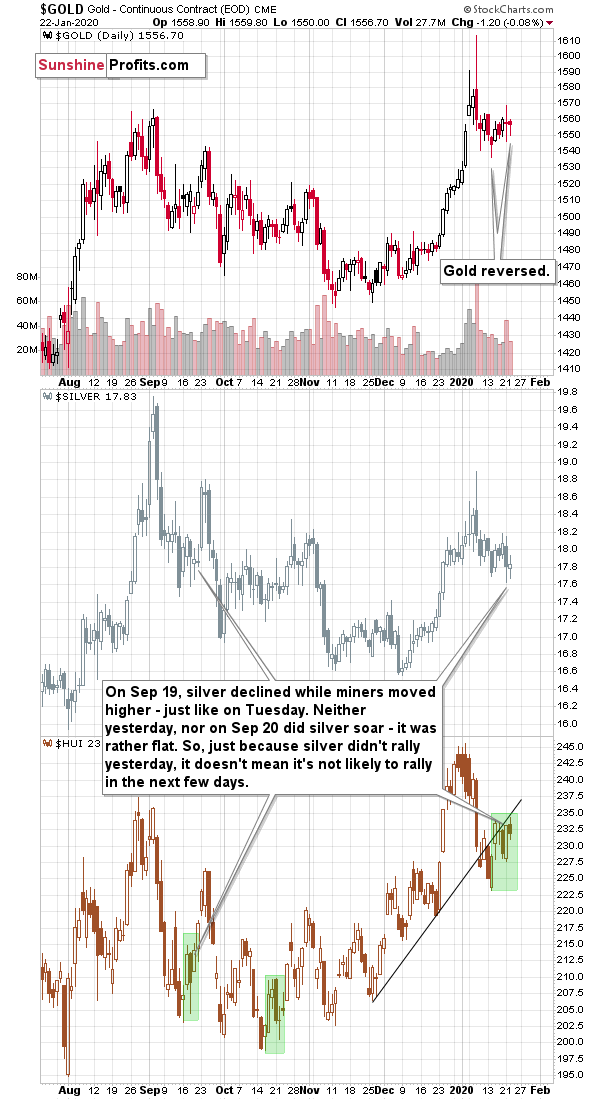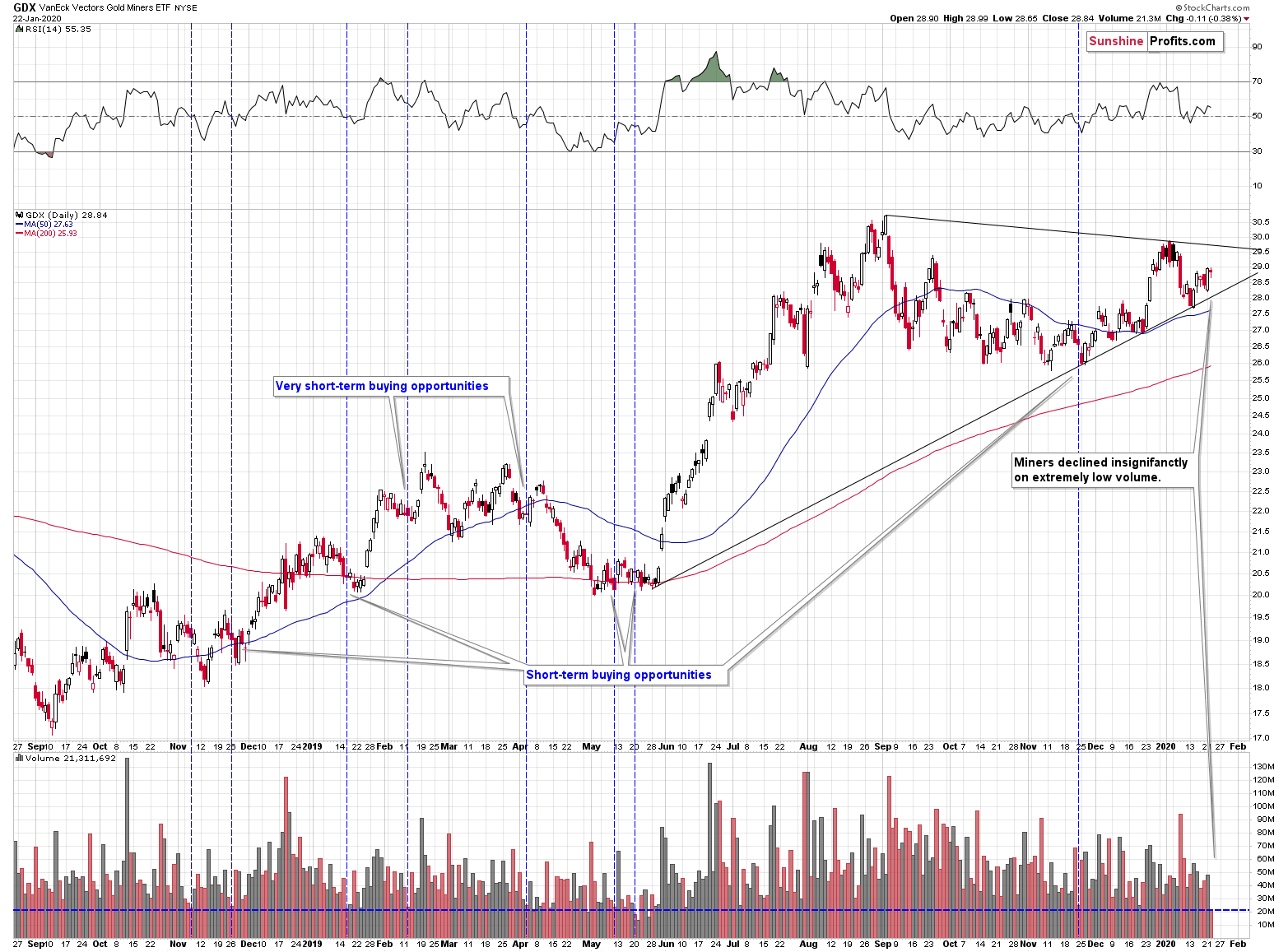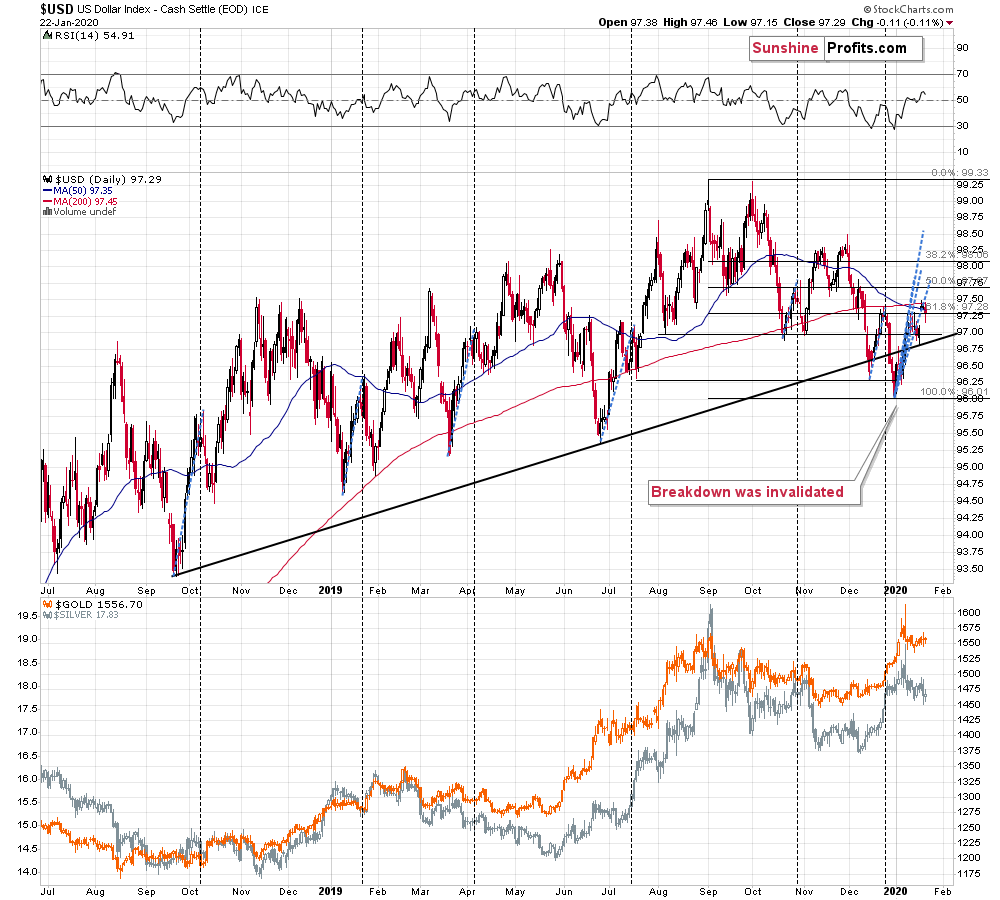Briefly: in our opinion, full speculative long position in silver is justified from the risk/reward point of view at the moment of publishing this Alert.
Not much happened yesterday and our yesterday's comments regarding long position in silver remain up-to-date. The white metal didn't soar immediately, but that doesn't change anything. Before, we proceed with commenting on yesterday's price moves and discussing the current short-term outlook, we would like to remind you that this position is against the big downtrend. The latter continues to be the most likely outcome due to myriads of reasons outlined in this week's flagship Gold & Silver Trading Alert. Yet, just because gold, silver, and mining stocks are likely to fall very far in the following months, it doesn't mean that there will be no periodic corrections and that some of them will be likely to provide good enough risk/reward situations that would justify going long. It seems that we have one of such situations right now.
What makes it bullish? It's mostly a matter of what happened during Tuesday's session. And more precisely, how it happened. How silver performed relative to gold, and - most importantly - relative to mining stocks. And the way the latter showed strength.
Following Up on the PMs Signal
What may seem surprising is that it was silver's weakness that actually increased its bullish potential.
People tend to view rallies as bullish and declines as bearish as if seeing something once made it more likely to happen on the next day too. But it isn't so. If it were, it would be possible for everyone to make money by simply going long after a daily rally; and going short after a daily decline. And yet, people are not doing it. Why? Because it doesn't generate returns on average, because this simple strategy doesn't work. Why again? Because daily rallies are not bullish by themselves, just as daily declines are not bearish on their own.
In fact, the opposite might be true to some very limited extent. After all, a decline needs to take place before the bottom, and everyone knows that its best to buy at the bottom. It's also best to sell something when it tops and to enter short positions at that time. And a rally must first take place for a top to form.
Most daily rallies and most daily declines, however, don't result in tops or bottoms. They are followed by some other price action. Therefore in most cases, a daily rally or a daily decline doesn't tell us anything about the way the price will move in the following days.
But.
While the price move itself doesn't tell us much, the same price move - in context - can tell us a lot. The context can be provided by news, by previous price moves of the same asset, or by price moves of related assets.
In case of news, we can detect anomalies and determine whether the market is reacting the way it should - if not, this might create a trading opportunity.
In case of the previous price moves, we can apply the classic technical analysis patterns, cyclical analysis and similar techniques.
The last case can provide sector-specific insights as some things might happen in a special way that doesn't take place in general and thus it's not covered by the classic technical rules. We saw this kind of signal on Tuesday.
Namely, mining stocks showed daily strength by soaring back to previous highs while gold did almost nothing in closing price terms, and silver actually declined. Overall, silver is close to its recent lows, while gold miners are close to their very recent highs. We've researched the relative performance of silver and mining stocks and to make long story short, miners tend to rally particularly strongly in the early part of a given rally, and silver tends to be relatively weak initially but soars in the final part of the rally.
Tuesday's session, combined with the relative performance of silver and miners that we saw recently, perfectly fits the "early part of the rally" situation as outlined above. That's exactly what miners and silver are supposed to do before the final part of the rally takes place.
There's also a confirmation of the above present in the mining stocks themselves. In this case, it's the second way the context plays an important role.
The green areas marked on the above chart show similar cases in mining stocks. Gold miners declined significantly at the beginning of the year, but they corrected with short-term strength. On Monday, we wrote that Friday's decline might have indicated that we just saw another short-term top, or it might have been a regular daily pause that we often see in the initial part of short-term upswings. Based on how miners rallied on Tuesday, it seems more likely that it was just a pause. Consequently, the situation is similar to what happened in mid-September 2019 and mid-October 2019.
The similarity to September 2019 is the key one, though. That was the corrective upswing after a big, sharp short-term decline and this is the kind of decline that we saw earlier this month. Silver's performance is also quite similar. On September 19, 2019, gold miners rallied strongly after the daily slide, while silver was unable to close above the previous day's closing price.
This means two things: that we were correct to close the short positions in the precious metals sector immediately after gold's Jan 14 reversal, and that silver is likely to enter its "big catch up" stage shortly.
What it didn't mean is that silver and the rest of the precious metals sector had to rally immediately. Conversely, based on the analogy to September 2019, a daily pause would be more likely to immediately follow. And that's exactly what we saw - a daily pause.
Back in September, mining stocks moved higher immediately after the above-mentioned session. This time, they didn't - but they did flash a bullish sign of their own.
Namely, miners moved a bit lower on extremely low volume.
The Miners Just Sent Their Own Signal
In the recent past, we saw only a handful of similar sessions and they were mostly good opportunities to go long. The above chart features 8 similar sessions. 5 out of them were good opportunities to go long in the short term, but not necessarily in the immediate term. 2 of them were good opportunities to go long in the very short term. The only remaining case - in early November 2018 - was followed by a very short-term downswing and then a rally.
In almost all cases, bullish price action followed, which confirms our bullish outlook for the short term (and short term only).
Also, let's keep in mind that the USD Index is still vulnerable to a corrective decline.
Checking Up on the USD Index
The blue lines show the times when the USD Index corrected meaningfully for the first time since bottoming in a meaningful way. We saw only a very modest correction so far, which means that this might have not been "it". Consequently, another quick slide could be in the cards for the USDX before its rally continues. Such a pullback would be a perfect trigger for the precious metals' upswing.
Yes - precious metals and mining stocks - not just silver. Gold and miners are likely to move higher too, but it seems that silver will move higher in a way that will be more visible than what we see in gold and mining stocks.
Miners might still rally higher in percentage terms, but it might be more difficult to exit such position close to the top. Please note that in late September 2019, the top in miners was just a one-day phenomenon and miners declined immediately thereafter. In case of silver, there were actually two more intraday highs when one could have exited the long position and enter the short one.
So, while we are usually diversifying between gold, silver, and mining stocks in our trades, this time - based on how silver declined recently and how miners rallied - it seems justified to take advantage of the extra opportunity that silver's relative performance provides.
Please note that we expect to keep this long position active only for several days.
Summary
Summing up, it seems that the final part of the corrective upswing in the precious metals market is still ahead of us, which is confirmed by several short-term signs, including yesterday's extremely low volume in the mining stocks. This means that silver is likely to rally particularly strong in the next several days. Consequently, before getting back on the short side of the precious metals market due to myriads of bearish medium-term factors, we aim to profit on a quick long trade in silver.
As always, we'll keep you - our subscribers - informed.
To summarize:
Trading capital (supplementary part of the portfolio; our opinion): Full speculative long position (100% of the full position) in silver is justified from the risk/reward perspective with the following stop-loss orders and binding exit profit-take price levels:
- Silver futures: profit-take exit price: $18.49; stop-loss: $17.46; initial target price for the USLV ETN: $99.97; stop-loss for the USLV ETN: $84.49
Long-term capital (core part of the portfolio; our opinion): No positions (in other words: cash)
Insurance capital (core part of the portfolio; our opinion): Full position
Whether you already subscribed or not, we encourage you to find out how to make the most of our alerts and read our replies to the most common alert-and-gold-trading-related-questions.
Please note that the in the trading section we describe the situation for the day that the alert is posted. In other words, it we are writing about a speculative position, it means that it is up-to-date on the day it was posted. We are also featuring the initial target prices, so that you can decide whether keeping a position on a given day is something that is in tune with your approach (some moves are too small for medium-term traders and some might appear too big for day-traders).
Plus, you might want to read why our stop-loss orders are usually relatively far from the current price.
Please note that a full position doesn't mean using all of the capital for a given trade. You will find details on our thoughts on gold portfolio structuring in the Key Insights section on our website.
As a reminder - "initial target price" means exactly that - an "initial" one, it's not a price level at which we suggest closing positions. If this becomes the case (like it did in the previous trade) we will refer to these levels as levels of exit orders (exactly as we've done previously). Stop-loss levels, however, are naturally not "initial", but something that, in our opinion, might be entered as an order.
Since it is impossible to synchronize target prices and stop-loss levels for all the ETFs and ETNs with the main markets that we provide these levels for (gold, silver and mining stocks - the GDX ETF), the stop-loss levels and target prices for other ETNs and ETF (among other: UGLD, DGLD, USLV, DSLV, NUGT, DUST, JNUG, JDST) are provided as supplementary, and not as "final". This means that if a stop-loss or a target level is reached for any of the "additional instruments" (DGLD for instance), but not for the "main instrument" (gold in this case), we will view positions in both gold and DGLD as still open and the stop-loss for DGLD would have to be moved lower. On the other hand, if gold moves to a stop-loss level but DGLD doesn't, then we will view both positions (in gold and DGLD) as closed. In other words, since it's not possible to be 100% certain that each related instrument moves to a given level when the underlying instrument does, we can't provide levels that would be binding. The levels that we do provide are our best estimate of the levels that will correspond to the levels in the underlying assets, but it will be the underlying assets that one will need to focus on regarding the signs pointing to closing a given position or keeping it open. We might adjust the levels in the "additional instruments" without adjusting the levels in the "main instruments", which will simply mean that we have improved our estimation of these levels, not that we changed our outlook on the markets. We are already working on a tool that would update these levels on a daily basis for the most popular ETFs, ETNs and individual mining stocks.
Our preferred ways to invest in and to trade gold along with the reasoning can be found in the how to buy gold section. Additionally, our preferred ETFs and ETNs can be found in our Gold & Silver ETF Ranking.
As a reminder, Gold & Silver Trading Alerts are posted before or on each trading day (we usually post them before the opening bell, but we don't promise doing that each day). If there's anything urgent, we will send you an additional small alert before posting the main one.
Thank you.
Sincerely,
Przemyslaw Radomski, CFA
Editor-in-chief, Gold & Silver Fund Manager






